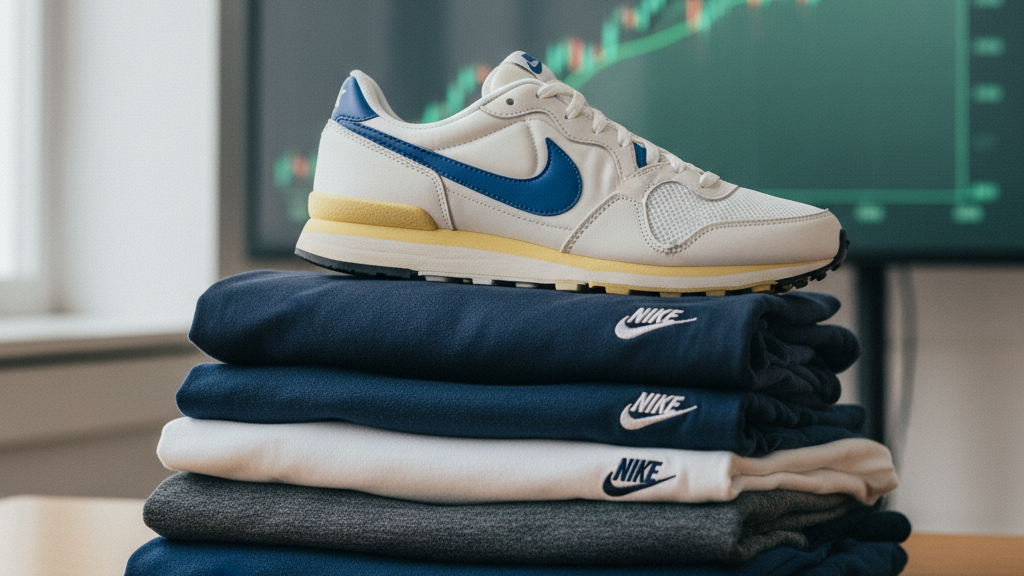Summary (TL;DR)
The bottom line for anyone watching the markets is that this event signals a potential turning point in the Nike turnaround story. Investors were braced for a significant revenue decline and deeply compressed profits, but Nike delivered a surprise: a return to year-over-year revenue growth and a much higher-than-expected profit. This double beat provided a critical boost of confidence, suggesting that CEO Elliott Hill’s “Win Now” strategy especially the renewed focus on wholesale partners and running innovation is starting to gain traction, even as challenges in China and digital sales persist. The market reacted by sending the stock higher in postmarket trading, interpreting the strong headline numbers as evidence that the worst of the company’s restructuring pain may be subsiding.
The Core News (What Happened?)
Nike, Inc. (NKE) reported its fiscal first-quarter (Q1 2026) results after the market close on Tuesday, significantly surpassing Wall Street’s expectations for both revenue and earnings per share (EPS). The company reported revenues of $11.7 billion, marking a 1% increase from the prior year and handily beating the consensus analyst forecast of around $11.0 billion.
The earnings performance was even more notable: Nike reported diluted EPS of $0.49, which was substantially higher than the forecasted $0.27. This surprise performance was largely attributed to better-than-expected growth in the wholesale channel, particularly in North America, which helped offset ongoing weakness in the direct-to-consumer (DTC) digital business and the Greater China market. The stock reacted positively to the news, seeing a jump in after-hours trading.
Background (Setting the Stage)
Coming into this earnings release, expectations for Nike were low. Analysts were generally predicting a tough quarter, viewing it as potentially the “trough” of the company’s recent restructuring efforts. The consensus had forecast a mid-single-digit revenue decline (around 5% year-over-year) and a sharp 60% drop in EPS compared to the prior year. This cautious outlook stemmed from persistent headwinds like a slowing consumer demand for lifestyle categories, a structural “reset” in the crucial China market, and the heavy financial impact of new U.S. tariffs on goods imported from China.
The actual results were a powerful upside surprise. Instead of a 5% decline, Nike delivered 1% revenue growth. Instead of 27 cents in profit, it delivered 49 cents. This significant beat on the top (revenue) and bottom (profit) lines suggested that the core business performance was more resilient than the market had assumed and provided the first tangible evidence that management’s recent strategic shifts are starting to generate positive financial outcomes.
The Debate (The Bull vs. Bear Case)

The Bull Case: Optimists believe this report is the first clear signal that the turnaround is taking hold. Analysts at Jefferies note that “Order book is now up two qtrs in a row and clean inventory levels show supply is matching demand,” suggesting fundamental health is returning. The key drivers of the optimism are:
- Wholesale Rebound: Wholesale revenue grew by 7%, showing success in the strategy to re-engage with key retail partners like Amazon and Foot Locker, an important reversal from the previous DTC-first approach.
- Geographic Strength: North America and Europe, Middle East, and Africa (EMEA) revenues showed solid growth (4% and 6%, respectively), proving demand remains strong in core established markets.
- Innovation Traction: The running category was cited as growing over 20%, an early win from the new focus on performance innovation and core sports.

The Bear Case: The cautious voices point to several red flags that indicate the recovery will be “uneven” and “non-linear,” a sentiment echoed by Nike’s CFO.
- Gross Margin Pressure: The gross margin (the profit the company makes on each sale before overhead) decreased by 320 basis points to 42.2%. This decline was steeper than expected, driven by higher discounts to clear inventory and the financial burden of new North American tariffs (which are estimated to cost the company $1.5 billion annually).
- Direct & Digital Weakness: NIKE Direct sales fell 4%, with a notable 12% decline in NIKE Brand Digital sales, indicating the company is struggling to maintain momentum in its owned online channel.
- Greater China Headwind: Revenue in Greater China, a critical long-term growth market, declined by 9%, highlighting that geopolitical and market challenges in that region are still a major drag on overall performance. Furthermore, management issued cautious guidance for Q2, expecting revenue to decline in the low single digits.
By the Numbers (Key Data & Metrics)
- Reported Revenue: $11.72 Billion (1% increase year-over-year)
- Consensus Revenue Expectation: Approximately $11.0 Billion
- Diluted Earnings Per Share (EPS): $0.49
- Consensus EPS Expectation: $0.27
- Gross Margin: 42.2%
- Wholesale Revenue: Up 7%
- NIKE Direct Revenue: Down 4% (including a 12% decline in digital sales)
- North America Revenue: Up 4%
- Greater China Revenue: Down 9%
- Inventory: Down 2% year-over-year
Disclaimer: This article is for informational purposes only and does not constitute financial, investment, or legal advice. The information provided is a synthesis of publicly available data and expert analysis and should not be considered a recommendation to buy or sell any security. Investing in the stock market involves risk, including the possible loss of principal. Past performance is not indicative of future results. Readers should consult with a qualified financial advisor to determine an investment strategy that is suitable for their own personal financial situation and risk tolerance.
Sources:
- NIKE, Inc. Reports Fiscal 2026 First Quarter Results – Nike Investor Relations
- Nike (NKE) Surprises With Q1 Revenue Gain as Turnaround Gains Traction
- Earnings call transcript: Nike beats Q1 2026 forecasts, stock edges up – Investing.com
- What analysts are saying about Nike after its earnings report (NKE:NYSE) | Seeking Alpha
- Nike sees stocks surge by 1.5% as revenues jump in Q1 – The Economic Times






















